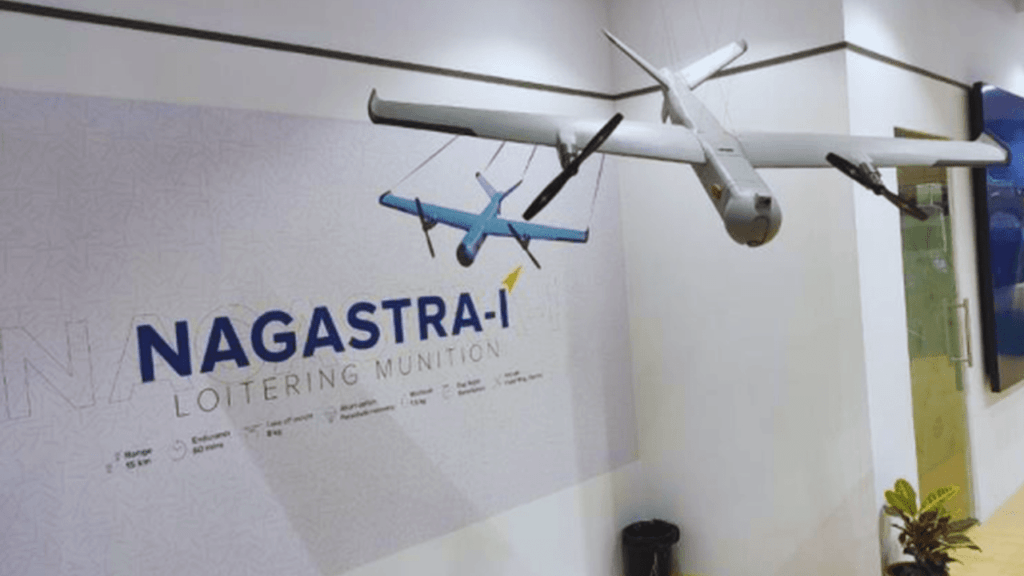
In a significant leap towards enhancing India’s defense capabilities, the Indian Army has received the first batch of indigenous man-portable suicide drones, named Nagastra-1. Developed by Nagpur-based Solar Industries, these drones promise to redefine modern warfare with their advanced features and precision strike capabilities. The induction of Nagastra-1 marks a crucial step in the Indian Army’s modernization efforts, particularly along the contentious borders with China and Pakistan.
Nagastra-1: A Revolutionary Addition to India’s Arsenal
The Nagastra-1 loitering munition is designed to neutralize hostile threats in ‘kamikaze mode,‘ executing GPS-enabled precision strikes with an impressive accuracy of up to two meters. This capability ensures that the drones can target enemy camps and other strategic points without risking the lives of soldiers. This first-of-its-kind system in India is tailored to meet the urgent operational requirements of the Indian Army, leveraging emergency procurement powers to facilitate rapid deployment.
Development and Delivery
The Indian Army placed an order for 480 Nagastra-1 drones with Solar Industries’ Economics Explosives Ltd (EEL), with 120 units already delivered following successful pre-delivery inspections. This initiative is a testament to India’s growing self-reliance in defense manufacturing, as the Nagastra-1 boasts over 75 percent indigenous content. This not only reduces dependency on foreign suppliers but also aligns with the ‘Make in India’ initiative aimed at bolstering domestic defense production.
Unique Features and Capabilities
Precision and Stealth
One of the standout features of the Nagastra-1 is its ability to conduct precision strikes. Equipped with GPS-enabled systems, the drone can hit targets with an accuracy of up to two meters. Additionally, its electric propulsion system ensures a low acoustic signature, making it virtually undetectable by the enemy at altitudes above 200 meters. This stealth capability is critical for missions requiring covert operations and minimal risk of detection.
Surveillance and Attack
The Nagastra-1 is fitted with day-and-night surveillance cameras, enhancing its operational versatility. This feature allows the drone to gather crucial intelligence and maintain situational awareness during both daylight and nighttime operations. Furthermore, the drone carries a 1 kg high-explosive fragmenting warhead, designed to neutralize soft-skin targets effectively. This combination of surveillance and firepower makes the Nagastra-1 a formidable asset on the battlefield.
Abort, Recover, and Reuse
A significant advantage of the Nagastra-1 over similar systems is its ability to abort missions when necessary. If a target is not detected or if the mission parameters change, the drone can be called back, utilizing a parachute recovery mechanism to ensure a soft landing. This feature allows the drone to be reused multiple times, offering both economic and operational benefits. The abort, recover, and reuse capabilities set the Nagastra-1 apart from other loitering munitions developed by advanced countries.

Tactical Specifications
Man-Portable System
The Nagastra-1 is designed to be man-portable, with an all-up weight of 30 kg distributed in two rucksacks. This includes the Ground Control Station, Communication Control, Payload, and Pneumatic Launcher, making it highly mobile and suitable for rapid deployment in various terrains.
Operational Range and Endurance
The drone has an endurance of 30 minutes, providing ample time for reconnaissance and strike missions within its operational range. The Nagastra-1 offers a man-in-loop control range of 15 km and can operate autonomously up to 30 km. This flexibility ensures that the drone can be deployed in diverse operational scenarios, from close-quarter engagements to longer-range missions.
Strategic Implications
The introduction of the Nagastra-1 into the Indian Army’s arsenal has far-reaching strategic implications. The ability to conduct precision strikes without risking human lives enhances the Army’s tactical capabilities, particularly in high-risk areas along the borders. The drone’s indigenous development also signifies a major step towards reducing India’s reliance on foreign defense technology, fostering a self-reliant defense ecosystem.
Comparative Advantage
Cost-Effectiveness
Compared to similar systems procured from foreign vendors, the Nagastra-1 is significantly more cost-effective. This economic advantage allows for the acquisition of a larger number of units, enhancing the Army’s operational flexibility and readiness.
Indigenous Innovation
The successful development and deployment of the Nagastra-1 underscore India’s growing prowess in defense innovation. With more than 75 percent indigenous content, the drone exemplifies the potential of Indian defense manufacturers to produce world-class military technology.
Conclusion
The Nagastra-1 suicide drone represents a significant advancement in India’s defense capabilities, combining precision, stealth, and versatility in a man-portable package. Developed by Solar Industries in collaboration with Z-Motion Autonomous Systems Pvt Ltd, the drone is poised to play a crucial role in enhancing the Indian Army’s operational effectiveness along the borders. As the first batch of Nagastra-1 drones is deployed, India takes a decisive step towards a more self-reliant and technologically advanced defense infrastructure.
In the context of modern warfare, drone technology has emerged as a force multiplier, with applications evident in various global conflicts. The Nagastra-1, with its unique features and indigenous design, positions India at the forefront of this technological revolution, promising a safer and more effective means of addressing security challenges.
Read Next:

The Psychology of Love: Why Valentines Day Matters More Epic Than You Think
Discover the psychology of love and why Valentines Day is more important than you think. Learn how love impacts the brain, strengthens relationships, and boosts

Premier League Highlights: Arsenal Humiliate Man City 5-1, Spurs and Palace Secure Crucial Wins
Arsenal demolished Manchester City 5-1 in a statement premier league highlights win, reigniting their title hopes. Meanwhile, Crystal Palace stunned Man United 2-0, and Tottenham

How Budget 2025 Impacts the Indian Middle-Class: Major Tax Benefits and Glaring Omissions
Budget 2025 offers major tax relief to the middle class, including zero tax on incomes up to ₹12 lakh. However, it misses out on incentives
